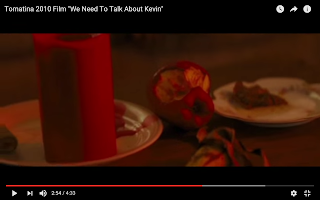- Opening shot is a fade into a dark room with chiffon white curtains blowing in a breeze from outside. This is foreshadowing as it appears later, with significance, in the film. The white of the curtains suggests innocence but this is ironic as we know that the film is revolved around Kevin who is the opposite of this.
- Slow zoom in. Non-diegetic sound of some sort of timer ticking, sounding as if it’s about to go off- symbolises time running out/tension being built until breaking point.
- Non-diegetic sound of people shouting out, but sounds far away. This suggests that it is a memory from the distant past. The ticking speeds up and becomes faster and faster, building to a climax.
- The light from outside the curtains blooms and the scene dissolves into an overhead shot of a packed crowd. The shouting and cheering of people becomes louder.
- The camera zooms into the crowd from above. As it gets closer, we can see that people are covered in tomatoes - the first semiotic, using the colour red, is displayed.
- The red connotes blood which foreshadows Kevin’s shooting.
- The liquified tomatoes are thrown everywhere - blood bath.
- Khatchadourian, our protagonist, is lifted above the crowds, above the fray - she appears happy and euphoric. The audience feels sympathy and nostalgia for her as we know these emotions are a thing of the past.
- The slow motion emphasises the serenity that she feels. She is lifted to form a cross, much like Jesus looked when he was crucified - perhaps representing sacrifice, martyrdom.
- She is then slowly dropped to the ground, into the sea of red tomatoes, people covering her in the substance. Close up on the intense red which looks disconcertingly similar to blood. This makes the audience feel uneasy and builds suspense, and the semiotics are building themes and foreshadowing of gore and death.
- Cuts back to the present - camera out of focus. Suggesting the tired, hazy vision from which Khatchadourian views her desolate world. Again, red is the most prominent colour.
- Camera comes into focus and pans, close up, across objects; red apple, red candle, ketchup. Warm light falls through the red stained windows, casting everything in a red glow.
- Pans up to show Khatchadourian asleep on the sofa - sad, skeletal. Wakes with regret - we instantly realise that she is depressed. The audience asks questions; why is she alone? Why does she feel this way?
- An eyeline match to a blurred shot of the window (again, the out-of-focus conveys her clouded vision of the world which now seems so distant to her.)
- Stands with difficulty - close up of her pained face - this builds intimacy and forms a sympathetic relationship with the protagonist.
- Knocks foot against table leg, pills fall to the floor - more connotations to depression. This draws the audience in further - how did she get into such a bad state?
- Attempts to open door, door handle breaks - symbolises her life which seems to be falling apart, her lack of care and upkeep of both her mental state and appearances.
- Bright, sunny light of street contrasts with the inside of the house which seems almost womb-like; provoking themes of maternity and comfort.
- Khatchadourian looks at her tiny white house which has been covered in bright red paint - again symbolising and foreshadowing blood. There is a clear visual link to the tomatoes which the audience instantly refers back to.
- She slowly returns inside, as if in defeat.
Friday, 7 October 2016
We Need To Talk About Kevin - Film Opening Analysis
Subscribe to:
Post Comments (Atom)







No comments:
Post a Comment